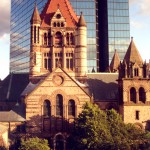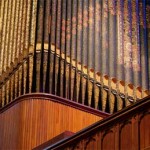Forty-five hundred trees pounded into alluvial muck hold up Trinity Church, a perennial presence on the American Institute of Architects’ shortlist of greatest buildings in America. Three men in their thirties made it happen: Phillips Brooks, the charismatic preacher from Philadelphia; architect Henry Hobson Richardson, as yet relatively untried but with sterling Harvard connections; and John La Farge, an artist known only for miniature watercolors. Together they transformed one another and American architecture with a “color church” light years distant from the era’s prevailing vocabulary. Richardson’s Greek-cross plan draws upon Romanesque churches in the Auvergne and the tower of Salamanca Cathedral, familiar to him only through books. La Farge’s mural program was the first in America, hastily completed under grueling winter conditions just in time for the church’s dedication in February 1877. Magnificent stained glass by La Farge, Oudinot, Clayton & Bell, Edward Burne Jones, and William Morris intensify the pervasive glow of Pompeian red. A number of young apprentices launched distinguished careers here, among them Augustus Saint Gaudens, Charles McKim, and Stanford White.
Music has formed an integral part of parish life since the arrival of the first organ, in 1744, and the Vestry’s decision, in 1785, to set aside a pew for “such Persons as chuse to set in it who are capable of leading in the Singing.” For a new building all about the progressive, the organ could come only from one builder: Hilborne Roosevelt of New York, famous for stringing a Vox Humana in the air at the 1876 Centennial Exposition and playing it electrically. The choice surely irked Boston builders; bad enough to buy that big concert organ from the Germans in 1863, but now this? Installed in the church’s southeast corner, the Roosevelt reached five stories tall, from water motors in the basement to an Echo in the chancel ceiling. The location muffled the tone, however, not only of the organ but also the singers occupying the same space. Before the building was even a year old, proposals surfaced to relocate all musical forces to the rear gallery.
Since then, music has ricocheted around the building. In 1881, organ and choir moved westward to the gallery, the Roosevelt divided on either side of La Farge’s “Christ in Majesty” window, its original stenciled façade incorporated into the asymmetrical array that remains today. In 1902, Trinity acceded to the fashion for vested choirs of men and boys, necessitating a chancel remodeling and, once more, a chancel organ. Built by Hutchings-Votey, the three-manual arrived on the northeast side in 1902. A console linking it with the gallery organ was inaugurated in April 1904.
In the 1920s, Ernest Skinner came to Trinity: first in 1924, with a few tonal changes and a towering four-manual console, then in 1926, with a brand-new, fifty-four-voice gallery organ. Louis Vierne singled it out for praise after a recital in April 1927. When the chancel was renovated again, in 1938, Ernest Skinner & Son made several tonal changes to both instruments. The 1926 thirty-two-foot Bombarde was switched out for a Fagotto, allowing Mr. Skinner to recycle the pipes into his organ for Washington National Cathedral.
Since then, the Trinity organs have tacked an American Classic course. The three-manual console Aeolian-Skinner provided in 1956 was a compact retort to its lofty predecessor. A new Aeolian-Skinner chancel organ arrived in 1960. Over the next decade, Skinner-trained technician Jason McKown refashioned the sound of both organs in collaboration with George Faxon, Trinity’s organist from 1954 to 1980. The gallery received a new Great flue chorus and Swell and Pedal chorus reeds from Aeolian-Skinner, while the chancel organ became more homogenous and less aggressive. The copper trumpet beneath the west window was added in 1987; voiced initially by Jack Steinkampf, it was later mellowed by David Broome. This is Boston’s most oft-heard pipe organ: three times each Sunday, weekly Wednesday evensong, and weekly Friday recitals.
Aeolian-Skinner Organ Co., Opus 573-C, 1961


